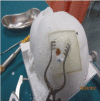3D printing materials and their use in medical education: a review of current technology and trends for the future
- PMID: 29354281
- PMCID: PMC5765850
- DOI: 10.1136/bmjstel-2017-000234
3D printing materials and their use in medical education: a review of current technology and trends for the future
Abstract
3D printing is a new technology in constant evolution. It has rapidly expanded and is now being used in health education. Patient-specific models with anatomical fidelity created from imaging dataset have the potential to significantly improve the knowledge and skills of a new generation of surgeons. This review outlines five technical steps required to complete a printed model: They include (1) selecting the anatomical area of interest, (2) the creation of the 3D geometry, (3) the optimisation of the file for the printing and the appropriate selection of (4) the 3D printer and (5) materials. All of these steps require time, expertise and money. A thorough understanding of educational needs is therefore essential in order to optimise educational value. At present, most of the available printing materials are rigid and therefore not optimum for flexibility and elasticity unlike biological tissue. We believe that the manipuation and tuning of material properties through the creation of composites and/or blending materials will eventually allow for the creation of patient-specific models which have both anatomical and tissue fidelity.
Keywords: 3d printing; medical simulation; simulators; surgical training; tissue fidelity.
Conflict of interest statement
Competing interests: None declared.
Figures

















References
-
- Negi S, Dhiman S, Kumar Sharma R. Basics and applications of rapid prototyping medical models. Rapid Prototyp J 2014;20:256–67. 10.1108/RPJ-07-2012-0065 - DOI
LinkOut - more resources
Full Text Sources
Other Literature Sources
